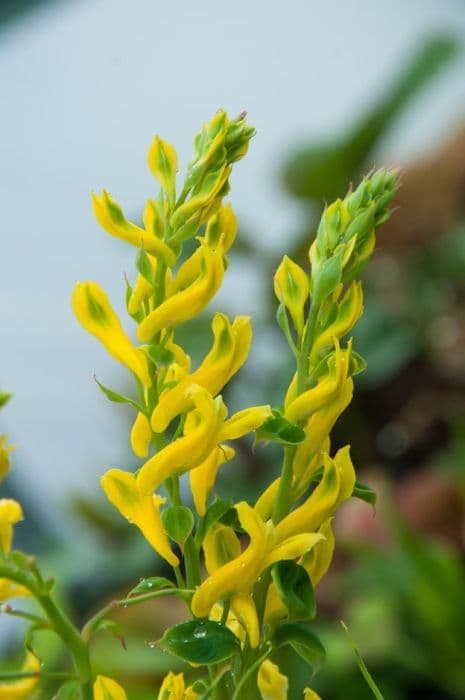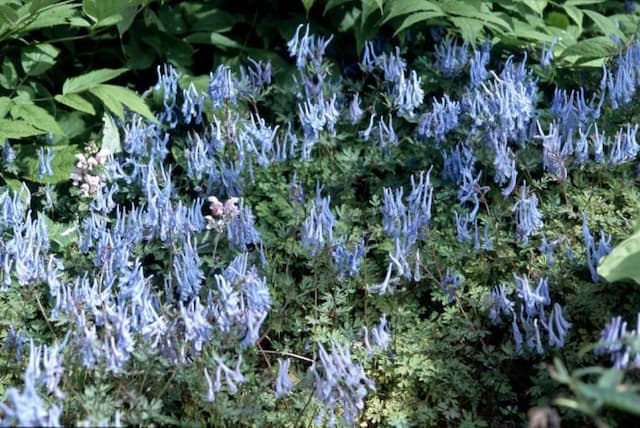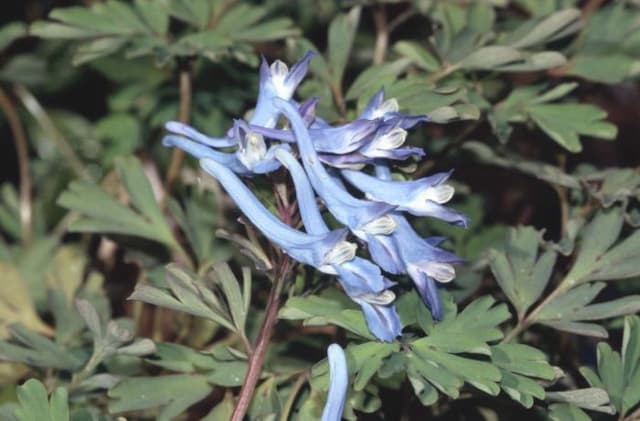Opium poppu 'Lauren's Grape' Papaver somniferum 'Lauren's Grape'
ABOUT
An upright annual, to 90cm tall, with deeply lobed, grey-green leaves and single, bowl-shaped, rich purple flowers, to 10cm across, with a glossy black basal blotch, which are followed by decorative pepperpot seedpods; good for cutting fresh or dried
About this plant
 Names
NamesFamily
Papaveraceae
Synonyms
Opium Poppy, Breadseed Poppy, Lauren's Grape Poppy
Common names
Papaver somniferum.
 Characteristics
CharacteristicsLife cycle
Annuals
Foliage type
Deciduous
Color of leaves
Blue-green
Flower color
Purple
Height
2-3 feet (60-90 cm)
Spread
1-1.5 feet (30-45 cm)
Plant type
Herb
Hardiness zones
7-10
Native area
Mediterranean
Benefits
 General Benefits
General Benefits- Ornamental Beauty: Papaver somniferum 'Lauren's Grape', commonly known as opium poppy, features stunning deep purple to burgundy flowers that add dramatic color to gardens and landscapes.
- Attracts Pollinators: The blooms provide a rich nectar source for bees and other pollinators, enhancing local biodiversity.
- Culinary Uses: The seeds of the opium poppy can be used in baking and cooking for their nutty flavor, although they don’t contain narcotic properties.
- Drought Tolerance: Once established, opium poppies are relatively drought-resistant, making them suitable for xeriscaping and low-water gardens.
- Easy to Grow: They are easy to cultivate from seeds and can grow in a variety of soil types, making them accessible to many gardeners.
- Self-Seeding: Opium poppies often self-seed, ensuring a recurring display year after year with minimal effort.
- Symbiotic Relationships: Planting opium poppies can contribute to creating a balanced ecosystem by supporting beneficial insects.
- Decorative Seed Pods: After flowering, opium poppies produce distinctive seed pods that are often used in dried floral arrangements and crafts.
- Variety of Uses in Landscape Design: They can be used as border plants, in mass plantings, or as part of a mixed flower bed, offering versatility in garden design.
- Seasonal Interest: Opium poppies have a specific blooming season, typically in late spring to early summer, which can be planned for in garden designs to ensure seasonal color and interest.
 Medical Properties
Medical Properties- Analgesic: Contains alkaloids such as morphine, used historically for pain relief.
- Sedative: Has sedative effects due to the presence of alkaloids like codeine.
- Antidiarrheal: The alkaloid codeine can be used to treat diarrhea.
- Cough suppressant: Codeine is a common cough suppressant due to its effects on the central nervous system.
 Air-purifying Qualities
Air-purifying QualitiesThis plant is not specifically known for air purifying qualities.
 Other Uses
Other Uses- Papaver somniferum 'Lauren's Grape', commonly known as opium poppy, can be used as a natural dye, where the petals provide a colorant for fabrics and cosmetics.
- The seeds of the opium poppy can be pressed to produce poppy seed oil, which is used in cooking and salad dressings due to its nutty flavor.
- Dried poppy pods are often used in flower arrangements and wreaths, adding a rustic appeal to floral decorations.
- The sturdy stems of the poppy can be used to create light-weight structures for model making or as a natural support in garden plant arrangements.
- Opium poppy petals, when crushed, can be mixed with other substances to create organic pigments for traditional painting techniques.
- The seeds are incorporated into birdseed mixtures as a nutritious food source for some bird species.
- When combined with water, poppy seeds can form a paste that is used as a moisturizing and exfoliating scrub in homemade skincare remedies.
- The empty seed pods can serve as biodegradable containers for starting small seeds or for craft projects due to their unique shape and texture.
- Beekeepers value opium poppies as a source of pollen, which supports honeybee populations and contributes to a diverse ecosystem in the garden.
- Opium poppy's fibrous stalks can be used in papermaking, providing an organic material for artisanal paper products.
Interesting Facts
 Feng Shui
Feng ShuiThe opium poppy is not used in Feng Shui practice.
 Zodiac Sign Compitability
Zodiac Sign CompitabilityThe opium poppy is not used in astrology practice.
 Plant Symbolism
Plant Symbolism- Peace: Poppies are often associated with peace and eternal sleep, reflecting on their sedative effects and the use of opium derived from Papaver somniferum.
- Remembrance: The poppy has become a symbol of remembrance for soldiers who have died in war, particularly since World War I, reflecting respect and honor for their sacrifices.
- Morpheus: In Greek mythology, the god of dreams, Morpheus, is connected to poppies due to the plant's soporific properties, symbolizing a deep connection with sleep and dreams.
- Death: Poppies can also symbolize death because of their link to opium and its potential deadliness, as well as their often blood-red color which could symbolize the blood of fallen soldiers.
- Resurrection and Eternal Life: The way poppies close at night and reopen in the morning is sometimes seen as a symbol of resurrection or eternal life, signifying renewal and rebirth.
 Water
WaterOpium poppy requires consistent moisture, particularly during the growing season. It's best to water the plant deeply once a week, providing about 1 to 1.5 inches of water. If the weather is particularly hot or dry, you may need to water twice a week. Always check the soil moisture level before watering; the soil should be moist but not waterlogged. Overwatering or letting the opium poppy sit in soggy soil can lead to root rot.
 Light
LightOpium poppy, 'Lauren's Grape', thrives best in full sun conditions. It should receive at least 6 to 8 hours of direct sunlight per day. The ideal spot for this plant is in a garden area where it can enjoy unfiltered sunlight for the majority of the day without being overshadowed by larger plants or structures.
 Temperature
TemperatureOpium poppies perform best in temperate climates and can withstand cooler temperatures down to about 20 degrees Fahrenheit. They grow optimally in temperatures ranging from 60 to 70 degrees Fahrenheit. However, sustained temperatures over 90 degrees Fahrenheit may stress the plant and affect its growth and flowering.
 Pruning
PruningPruning opium poppy is not typically necessary for the health of the plant, but deadheading spent flowers can encourage more blooms. After flowering, you can cut back the stems to ground level, encouraging a tidy appearance. Pruning should be done after the blooming period and before the seed pods have fully matured if you do not wish to collect seeds.
 Cleaning
CleaningAs needed
 Soil
SoilOpium poppy 'Lauren's Grape' prefers well-draining soil with a pH ranging from 6.0 to 7.5. A mix of loamy garden soil with added compost and sand or perlite will enhance drainage. Avoid soil that retains too much moisture to prevent root rot.
 Repotting
RepottingOpium poppies like 'Lauren's Grape' are annuals and typically do not require repotting as they are sown directly where they are to flower and will complete their life cycle in one season.
 Humidity & Misting
Humidity & MistingOpium poppy 'Lauren's Grape' is tolerant of a wide range of humidity levels and does best with average room humidity. It does not require high humidity to thrive.
 Suitable locations
Suitable locationsIndoor
Place in a bright spot; soil should be well-drained.
Outdoor
Plant in full sun, well-drained soil, after the last frost.
Hardiness zone
7-10 USDA
 Life cycle
Life cyclePapaver somniferum 'Lauren's Grape', commonly known as the opium poppy or breadseed poppy, begins its life cycle when the seeds germinate in early spring, after which the seedlings establish a small rosette of leaves close to the ground. As temperatures rise, the plant develops a taller stem and begins to form distinctive hairy, bluish-green foliage. Flower buds appear followed by the blooming of its characteristic deep-purple to burgundy flowers, which last for several days before the petals drop, leaving behind a seed pod. The seed pods mature, becoming larger as the seeds develop inside, and when fully ripe, the pods turn brown, dry out, and crack open to release the seeds. The plant completes its annual life cycle with the dispersal of seeds, which can lie dormant in the soil over winter until the next suitable growth period. If not harvested by humans or dispersed by natural means, the seeds can self-sow, initiating a new life cycle the following spring.
 Propogation
PropogationPropogation time
Spring-Early Summer
Papaver somniferum 'Lauren's Grape', commonly known as the opium poppy, is typically propagated by seed. The best time to sow the seeds is in early spring, as soon as the soil can be worked and the risk of frost has passed. To propagate, scatter the tiny seeds directly onto the surface of well-drained soil in a sunny location. Because the seeds need light to germinate, they should not be covered with soil but can be gently pressed into the earth to ensure good contact. Maintain a consistent moisture level in the soil until germination, which usually occurs within 10 to 14 days. Thin the seedlings to stand 6 to 8 inches apart to allow proper ventilation and sunlight exposure to each plant. This method of propagation is popular for its simplicity and effectiveness, allowing gardeners to grow healthy opium poppies with minimal equipment or horticultural expertise.









